Business Environment Analysis of ALDI: Comprehensive Report
VerifiedAdded on 2020/07/23
|15
|5025
|38
Report
AI Summary
This report offers a comprehensive analysis of ALDI's business environment, examining various internal and external factors impacting its operations. It begins with an introduction to the business environment and provides an overview of ALDI, a prominent supermarket chain with a global presence. The report delves into different types of business organizations, including profit, non-profit, and non-governmental organizations, discussing their purposes and supply of goods or services. It further explores the size and scope of organizations, differentiating between micro, small, medium, and large enterprises, and analyzing their market share, profit share, growth, and sustainability. The report then examines organizational structures and functions, focusing on the structures of private organizations like ALDI and public organizations like the NHS. The report also includes a PESTEL analysis of the UK retail industry and internal and external analyses of ALDI, along with an exploration of the interrelation of strengths and weaknesses with external macro factors. The report concludes by summarizing the key findings and providing references for further study.
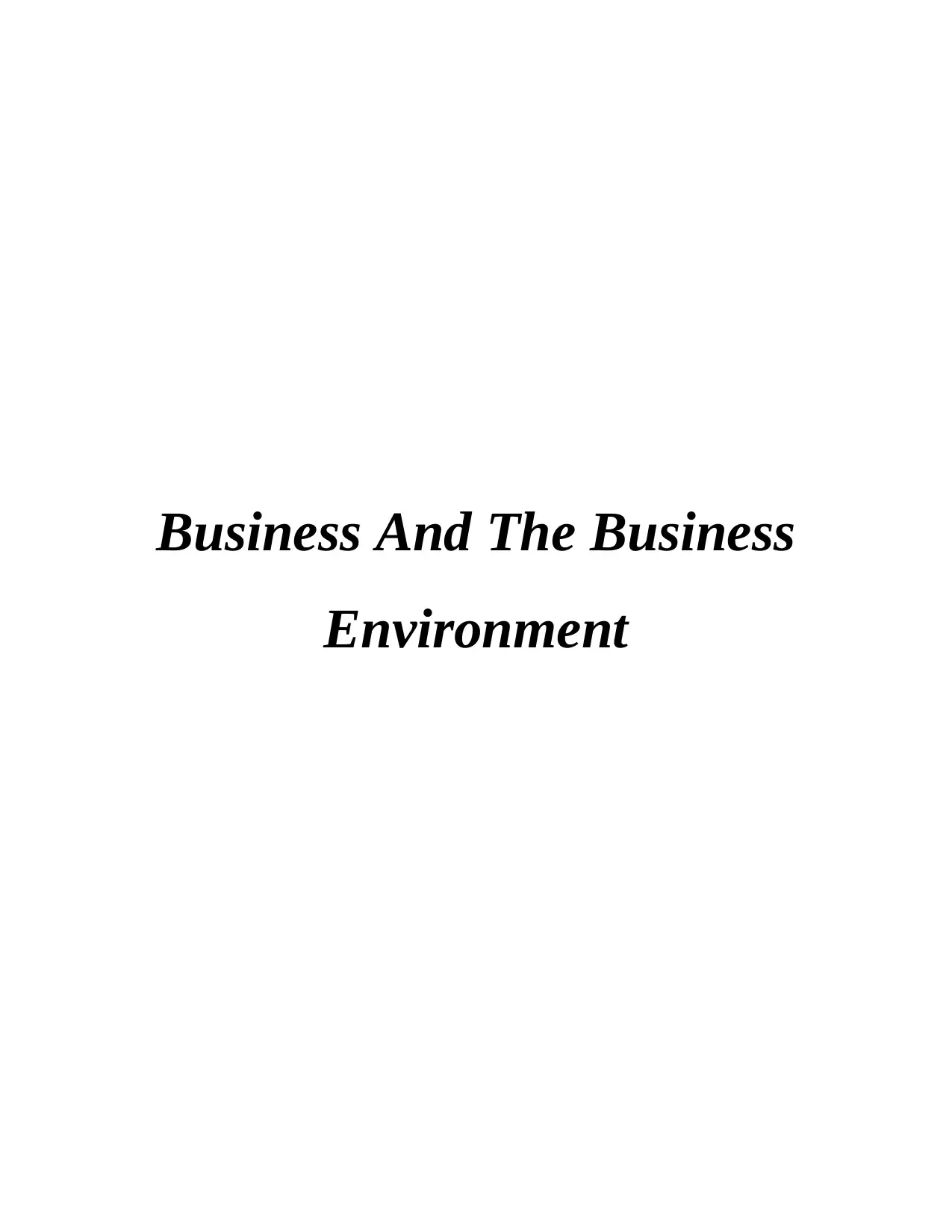
Business And The Business
Environment
Environment
Paraphrase This Document
Need a fresh take? Get an instant paraphrase of this document with our AI Paraphraser
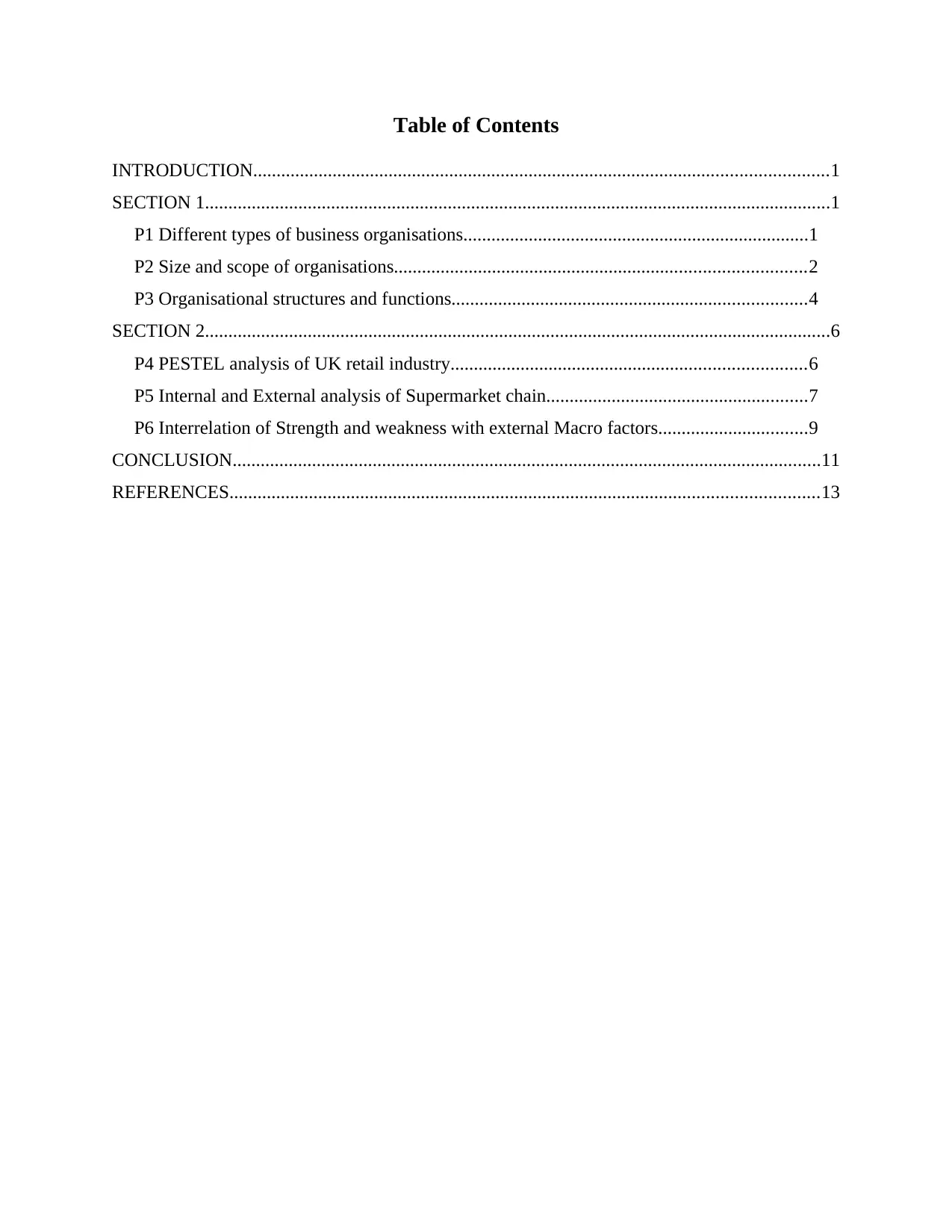
Table of Contents
INTRODUCTION...........................................................................................................................1
SECTION 1......................................................................................................................................1
P1 Different types of business organisations..........................................................................1
P2 Size and scope of organisations........................................................................................2
P3 Organisational structures and functions............................................................................4
SECTION 2......................................................................................................................................6
P4 PESTEL analysis of UK retail industry............................................................................6
P5 Internal and External analysis of Supermarket chain........................................................7
P6 Interrelation of Strength and weakness with external Macro factors................................9
CONCLUSION..............................................................................................................................11
REFERENCES..............................................................................................................................13
INTRODUCTION...........................................................................................................................1
SECTION 1......................................................................................................................................1
P1 Different types of business organisations..........................................................................1
P2 Size and scope of organisations........................................................................................2
P3 Organisational structures and functions............................................................................4
SECTION 2......................................................................................................................................6
P4 PESTEL analysis of UK retail industry............................................................................6
P5 Internal and External analysis of Supermarket chain........................................................7
P6 Interrelation of Strength and weakness with external Macro factors................................9
CONCLUSION..............................................................................................................................11
REFERENCES..............................................................................................................................13
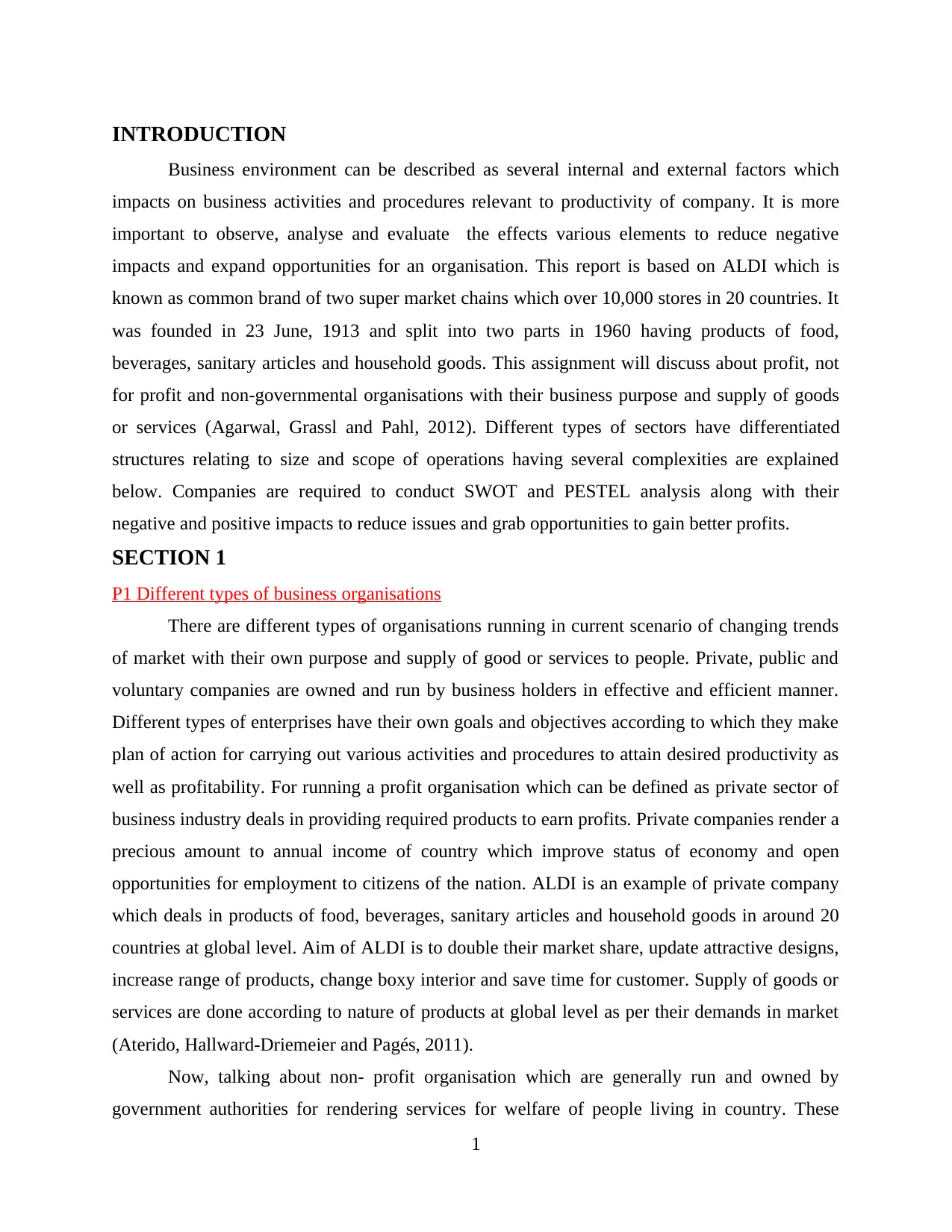
INTRODUCTION
Business environment can be described as several internal and external factors which
impacts on business activities and procedures relevant to productivity of company. It is more
important to observe, analyse and evaluate the effects various elements to reduce negative
impacts and expand opportunities for an organisation. This report is based on ALDI which is
known as common brand of two super market chains which over 10,000 stores in 20 countries. It
was founded in 23 June, 1913 and split into two parts in 1960 having products of food,
beverages, sanitary articles and household goods. This assignment will discuss about profit, not
for profit and non-governmental organisations with their business purpose and supply of goods
or services (Agarwal, Grassl and Pahl, 2012). Different types of sectors have differentiated
structures relating to size and scope of operations having several complexities are explained
below. Companies are required to conduct SWOT and PESTEL analysis along with their
negative and positive impacts to reduce issues and grab opportunities to gain better profits.
SECTION 1
P1 Different types of business organisations
There are different types of organisations running in current scenario of changing trends
of market with their own purpose and supply of good or services to people. Private, public and
voluntary companies are owned and run by business holders in effective and efficient manner.
Different types of enterprises have their own goals and objectives according to which they make
plan of action for carrying out various activities and procedures to attain desired productivity as
well as profitability. For running a profit organisation which can be defined as private sector of
business industry deals in providing required products to earn profits. Private companies render a
precious amount to annual income of country which improve status of economy and open
opportunities for employment to citizens of the nation. ALDI is an example of private company
which deals in products of food, beverages, sanitary articles and household goods in around 20
countries at global level. Aim of ALDI is to double their market share, update attractive designs,
increase range of products, change boxy interior and save time for customer. Supply of goods or
services are done according to nature of products at global level as per their demands in market
(Aterido, Hallward-Driemeier and Pagés, 2011).
Now, talking about non- profit organisation which are generally run and owned by
government authorities for rendering services for welfare of people living in country. These
1
Business environment can be described as several internal and external factors which
impacts on business activities and procedures relevant to productivity of company. It is more
important to observe, analyse and evaluate the effects various elements to reduce negative
impacts and expand opportunities for an organisation. This report is based on ALDI which is
known as common brand of two super market chains which over 10,000 stores in 20 countries. It
was founded in 23 June, 1913 and split into two parts in 1960 having products of food,
beverages, sanitary articles and household goods. This assignment will discuss about profit, not
for profit and non-governmental organisations with their business purpose and supply of goods
or services (Agarwal, Grassl and Pahl, 2012). Different types of sectors have differentiated
structures relating to size and scope of operations having several complexities are explained
below. Companies are required to conduct SWOT and PESTEL analysis along with their
negative and positive impacts to reduce issues and grab opportunities to gain better profits.
SECTION 1
P1 Different types of business organisations
There are different types of organisations running in current scenario of changing trends
of market with their own purpose and supply of good or services to people. Private, public and
voluntary companies are owned and run by business holders in effective and efficient manner.
Different types of enterprises have their own goals and objectives according to which they make
plan of action for carrying out various activities and procedures to attain desired productivity as
well as profitability. For running a profit organisation which can be defined as private sector of
business industry deals in providing required products to earn profits. Private companies render a
precious amount to annual income of country which improve status of economy and open
opportunities for employment to citizens of the nation. ALDI is an example of private company
which deals in products of food, beverages, sanitary articles and household goods in around 20
countries at global level. Aim of ALDI is to double their market share, update attractive designs,
increase range of products, change boxy interior and save time for customer. Supply of goods or
services are done according to nature of products at global level as per their demands in market
(Aterido, Hallward-Driemeier and Pagés, 2011).
Now, talking about non- profit organisation which are generally run and owned by
government authorities for rendering services for welfare of people living in country. These
1
⊘ This is a preview!⊘
Do you want full access?
Subscribe today to unlock all pages.

Trusted by 1+ million students worldwide
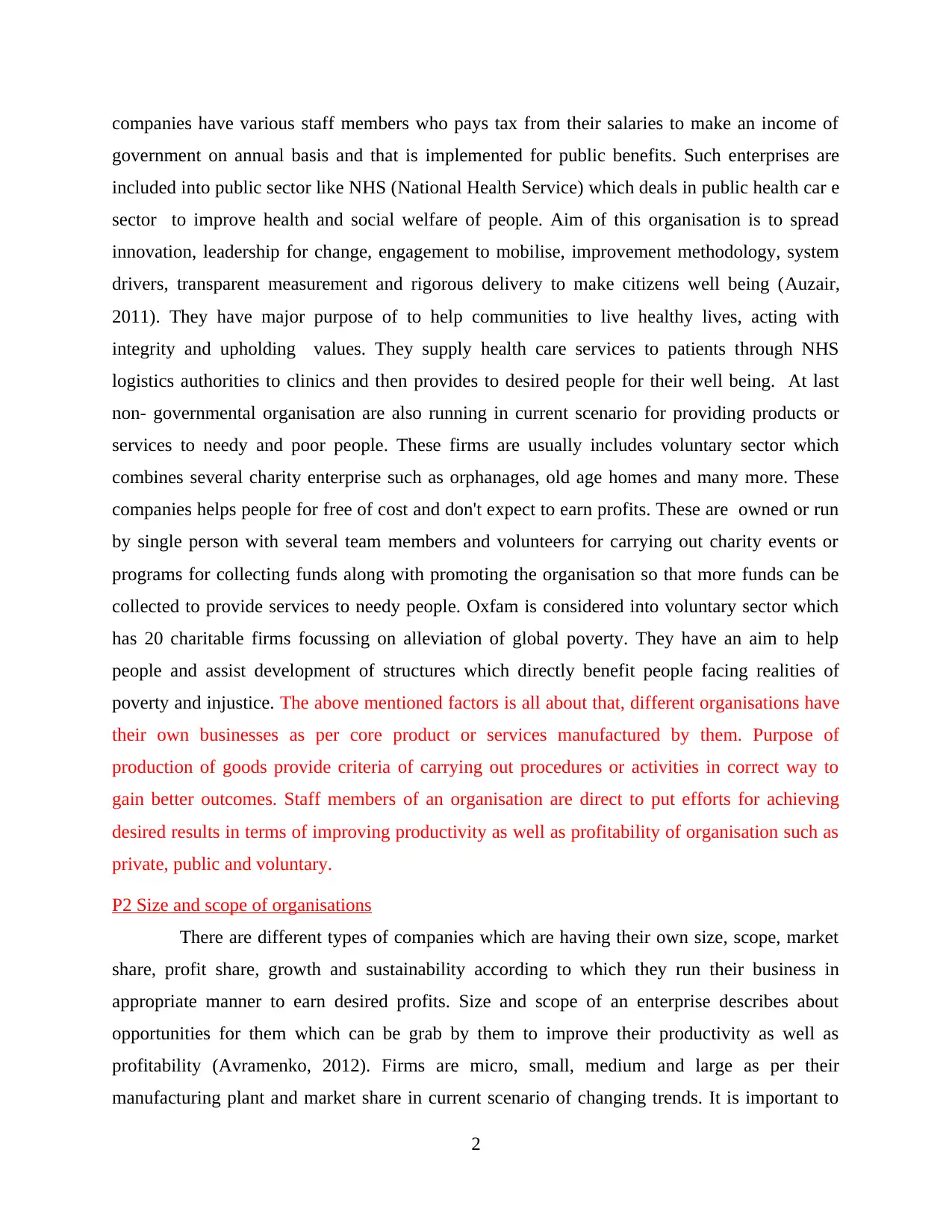
companies have various staff members who pays tax from their salaries to make an income of
government on annual basis and that is implemented for public benefits. Such enterprises are
included into public sector like NHS (National Health Service) which deals in public health car e
sector to improve health and social welfare of people. Aim of this organisation is to spread
innovation, leadership for change, engagement to mobilise, improvement methodology, system
drivers, transparent measurement and rigorous delivery to make citizens well being (Auzair,
2011). They have major purpose of to help communities to live healthy lives, acting with
integrity and upholding values. They supply health care services to patients through NHS
logistics authorities to clinics and then provides to desired people for their well being. At last
non- governmental organisation are also running in current scenario for providing products or
services to needy and poor people. These firms are usually includes voluntary sector which
combines several charity enterprise such as orphanages, old age homes and many more. These
companies helps people for free of cost and don't expect to earn profits. These are owned or run
by single person with several team members and volunteers for carrying out charity events or
programs for collecting funds along with promoting the organisation so that more funds can be
collected to provide services to needy people. Oxfam is considered into voluntary sector which
has 20 charitable firms focussing on alleviation of global poverty. They have an aim to help
people and assist development of structures which directly benefit people facing realities of
poverty and injustice. The above mentioned factors is all about that, different organisations have
their own businesses as per core product or services manufactured by them. Purpose of
production of goods provide criteria of carrying out procedures or activities in correct way to
gain better outcomes. Staff members of an organisation are direct to put efforts for achieving
desired results in terms of improving productivity as well as profitability of organisation such as
private, public and voluntary.
P2 Size and scope of organisations
There are different types of companies which are having their own size, scope, market
share, profit share, growth and sustainability according to which they run their business in
appropriate manner to earn desired profits. Size and scope of an enterprise describes about
opportunities for them which can be grab by them to improve their productivity as well as
profitability (Avramenko, 2012). Firms are micro, small, medium and large as per their
manufacturing plant and market share in current scenario of changing trends. It is important to
2
government on annual basis and that is implemented for public benefits. Such enterprises are
included into public sector like NHS (National Health Service) which deals in public health car e
sector to improve health and social welfare of people. Aim of this organisation is to spread
innovation, leadership for change, engagement to mobilise, improvement methodology, system
drivers, transparent measurement and rigorous delivery to make citizens well being (Auzair,
2011). They have major purpose of to help communities to live healthy lives, acting with
integrity and upholding values. They supply health care services to patients through NHS
logistics authorities to clinics and then provides to desired people for their well being. At last
non- governmental organisation are also running in current scenario for providing products or
services to needy and poor people. These firms are usually includes voluntary sector which
combines several charity enterprise such as orphanages, old age homes and many more. These
companies helps people for free of cost and don't expect to earn profits. These are owned or run
by single person with several team members and volunteers for carrying out charity events or
programs for collecting funds along with promoting the organisation so that more funds can be
collected to provide services to needy people. Oxfam is considered into voluntary sector which
has 20 charitable firms focussing on alleviation of global poverty. They have an aim to help
people and assist development of structures which directly benefit people facing realities of
poverty and injustice. The above mentioned factors is all about that, different organisations have
their own businesses as per core product or services manufactured by them. Purpose of
production of goods provide criteria of carrying out procedures or activities in correct way to
gain better outcomes. Staff members of an organisation are direct to put efforts for achieving
desired results in terms of improving productivity as well as profitability of organisation such as
private, public and voluntary.
P2 Size and scope of organisations
There are different types of companies which are having their own size, scope, market
share, profit share, growth and sustainability according to which they run their business in
appropriate manner to earn desired profits. Size and scope of an enterprise describes about
opportunities for them which can be grab by them to improve their productivity as well as
profitability (Avramenko, 2012). Firms are micro, small, medium and large as per their
manufacturing plant and market share in current scenario of changing trends. It is important to
2
Paraphrase This Document
Need a fresh take? Get an instant paraphrase of this document with our AI Paraphraser
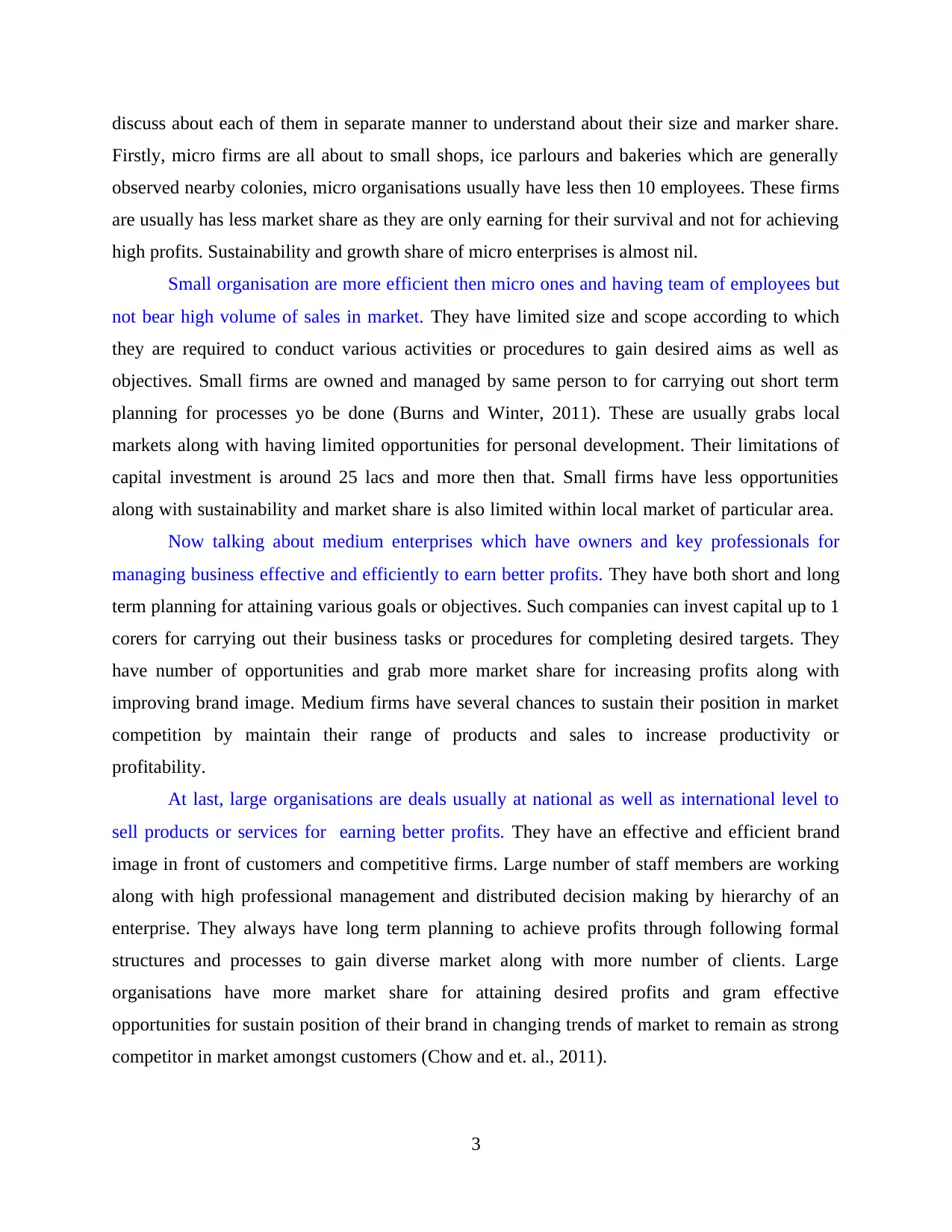
discuss about each of them in separate manner to understand about their size and marker share.
Firstly, micro firms are all about to small shops, ice parlours and bakeries which are generally
observed nearby colonies, micro organisations usually have less then 10 employees. These firms
are usually has less market share as they are only earning for their survival and not for achieving
high profits. Sustainability and growth share of micro enterprises is almost nil.
Small organisation are more efficient then micro ones and having team of employees but
not bear high volume of sales in market. They have limited size and scope according to which
they are required to conduct various activities or procedures to gain desired aims as well as
objectives. Small firms are owned and managed by same person to for carrying out short term
planning for processes yo be done (Burns and Winter, 2011). These are usually grabs local
markets along with having limited opportunities for personal development. Their limitations of
capital investment is around 25 lacs and more then that. Small firms have less opportunities
along with sustainability and market share is also limited within local market of particular area.
Now talking about medium enterprises which have owners and key professionals for
managing business effective and efficiently to earn better profits. They have both short and long
term planning for attaining various goals or objectives. Such companies can invest capital up to 1
corers for carrying out their business tasks or procedures for completing desired targets. They
have number of opportunities and grab more market share for increasing profits along with
improving brand image. Medium firms have several chances to sustain their position in market
competition by maintain their range of products and sales to increase productivity or
profitability.
At last, large organisations are deals usually at national as well as international level to
sell products or services for earning better profits. They have an effective and efficient brand
image in front of customers and competitive firms. Large number of staff members are working
along with high professional management and distributed decision making by hierarchy of an
enterprise. They always have long term planning to achieve profits through following formal
structures and processes to gain diverse market along with more number of clients. Large
organisations have more market share for attaining desired profits and gram effective
opportunities for sustain position of their brand in changing trends of market to remain as strong
competitor in market amongst customers (Chow and et. al., 2011).
3
Firstly, micro firms are all about to small shops, ice parlours and bakeries which are generally
observed nearby colonies, micro organisations usually have less then 10 employees. These firms
are usually has less market share as they are only earning for their survival and not for achieving
high profits. Sustainability and growth share of micro enterprises is almost nil.
Small organisation are more efficient then micro ones and having team of employees but
not bear high volume of sales in market. They have limited size and scope according to which
they are required to conduct various activities or procedures to gain desired aims as well as
objectives. Small firms are owned and managed by same person to for carrying out short term
planning for processes yo be done (Burns and Winter, 2011). These are usually grabs local
markets along with having limited opportunities for personal development. Their limitations of
capital investment is around 25 lacs and more then that. Small firms have less opportunities
along with sustainability and market share is also limited within local market of particular area.
Now talking about medium enterprises which have owners and key professionals for
managing business effective and efficiently to earn better profits. They have both short and long
term planning for attaining various goals or objectives. Such companies can invest capital up to 1
corers for carrying out their business tasks or procedures for completing desired targets. They
have number of opportunities and grab more market share for increasing profits along with
improving brand image. Medium firms have several chances to sustain their position in market
competition by maintain their range of products and sales to increase productivity or
profitability.
At last, large organisations are deals usually at national as well as international level to
sell products or services for earning better profits. They have an effective and efficient brand
image in front of customers and competitive firms. Large number of staff members are working
along with high professional management and distributed decision making by hierarchy of an
enterprise. They always have long term planning to achieve profits through following formal
structures and processes to gain diverse market along with more number of clients. Large
organisations have more market share for attaining desired profits and gram effective
opportunities for sustain position of their brand in changing trends of market to remain as strong
competitor in market amongst customers (Chow and et. al., 2011).
3
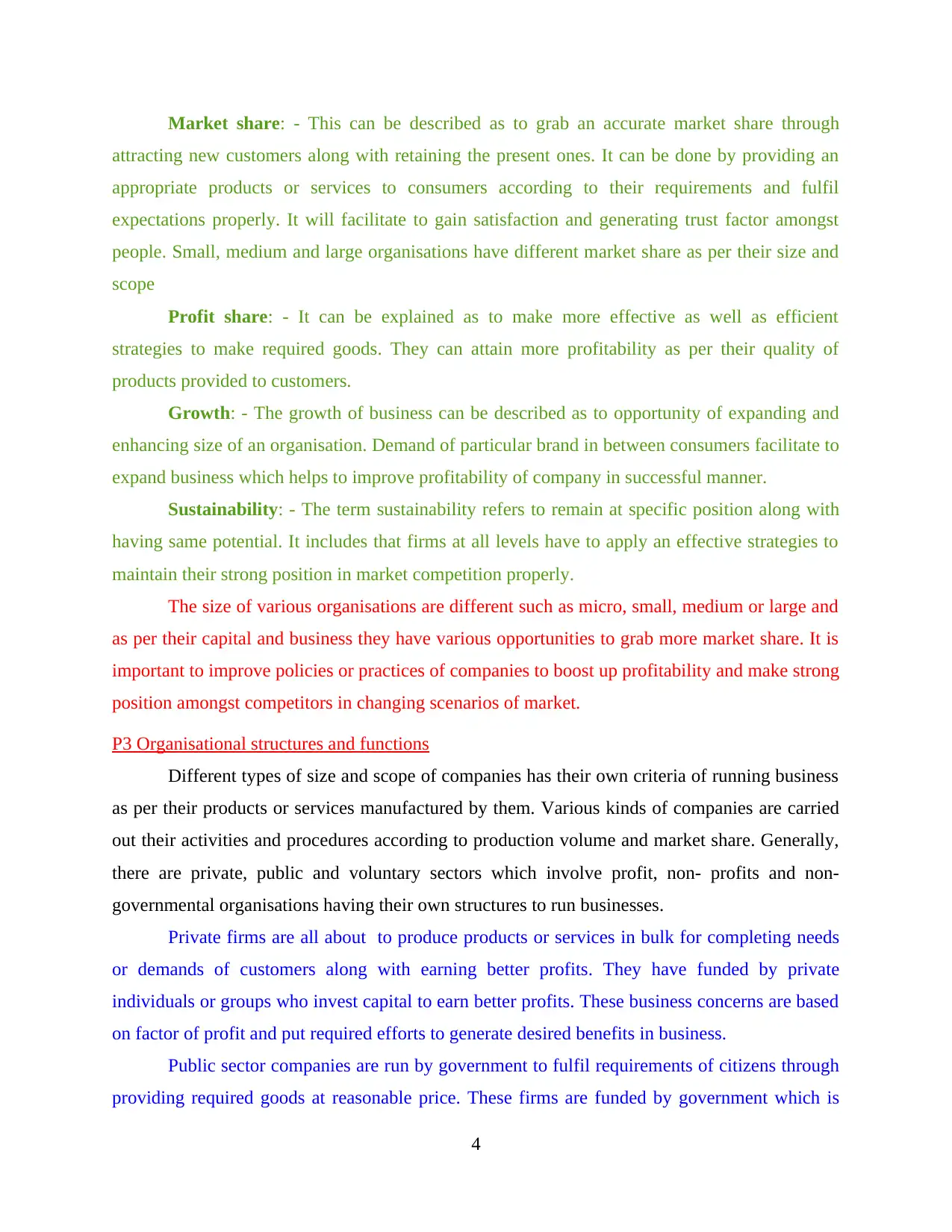
Market share: - This can be described as to grab an accurate market share through
attracting new customers along with retaining the present ones. It can be done by providing an
appropriate products or services to consumers according to their requirements and fulfil
expectations properly. It will facilitate to gain satisfaction and generating trust factor amongst
people. Small, medium and large organisations have different market share as per their size and
scope
Profit share: - It can be explained as to make more effective as well as efficient
strategies to make required goods. They can attain more profitability as per their quality of
products provided to customers.
Growth: - The growth of business can be described as to opportunity of expanding and
enhancing size of an organisation. Demand of particular brand in between consumers facilitate to
expand business which helps to improve profitability of company in successful manner.
Sustainability: - The term sustainability refers to remain at specific position along with
having same potential. It includes that firms at all levels have to apply an effective strategies to
maintain their strong position in market competition properly.
The size of various organisations are different such as micro, small, medium or large and
as per their capital and business they have various opportunities to grab more market share. It is
important to improve policies or practices of companies to boost up profitability and make strong
position amongst competitors in changing scenarios of market.
P3 Organisational structures and functions
Different types of size and scope of companies has their own criteria of running business
as per their products or services manufactured by them. Various kinds of companies are carried
out their activities and procedures according to production volume and market share. Generally,
there are private, public and voluntary sectors which involve profit, non- profits and non-
governmental organisations having their own structures to run businesses.
Private firms are all about to produce products or services in bulk for completing needs
or demands of customers along with earning better profits. They have funded by private
individuals or groups who invest capital to earn better profits. These business concerns are based
on factor of profit and put required efforts to generate desired benefits in business.
Public sector companies are run by government to fulfil requirements of citizens through
providing required goods at reasonable price. These firms are funded by government which is
4
attracting new customers along with retaining the present ones. It can be done by providing an
appropriate products or services to consumers according to their requirements and fulfil
expectations properly. It will facilitate to gain satisfaction and generating trust factor amongst
people. Small, medium and large organisations have different market share as per their size and
scope
Profit share: - It can be explained as to make more effective as well as efficient
strategies to make required goods. They can attain more profitability as per their quality of
products provided to customers.
Growth: - The growth of business can be described as to opportunity of expanding and
enhancing size of an organisation. Demand of particular brand in between consumers facilitate to
expand business which helps to improve profitability of company in successful manner.
Sustainability: - The term sustainability refers to remain at specific position along with
having same potential. It includes that firms at all levels have to apply an effective strategies to
maintain their strong position in market competition properly.
The size of various organisations are different such as micro, small, medium or large and
as per their capital and business they have various opportunities to grab more market share. It is
important to improve policies or practices of companies to boost up profitability and make strong
position amongst competitors in changing scenarios of market.
P3 Organisational structures and functions
Different types of size and scope of companies has their own criteria of running business
as per their products or services manufactured by them. Various kinds of companies are carried
out their activities and procedures according to production volume and market share. Generally,
there are private, public and voluntary sectors which involve profit, non- profits and non-
governmental organisations having their own structures to run businesses.
Private firms are all about to produce products or services in bulk for completing needs
or demands of customers along with earning better profits. They have funded by private
individuals or groups who invest capital to earn better profits. These business concerns are based
on factor of profit and put required efforts to generate desired benefits in business.
Public sector companies are run by government to fulfil requirements of citizens through
providing required goods at reasonable price. These firms are funded by government which is
4
⊘ This is a preview!⊘
Do you want full access?
Subscribe today to unlock all pages.

Trusted by 1+ million students worldwide
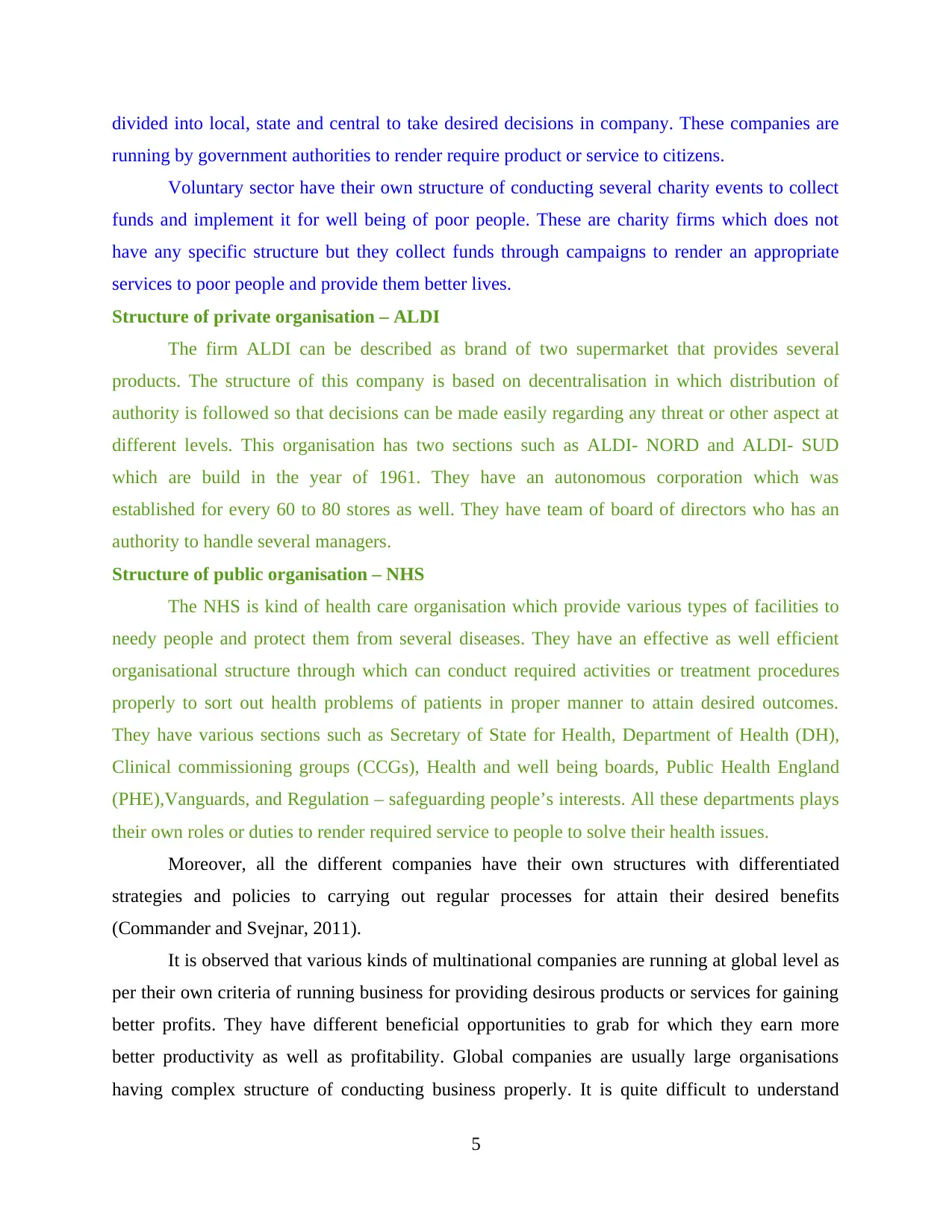
divided into local, state and central to take desired decisions in company. These companies are
running by government authorities to render require product or service to citizens.
Voluntary sector have their own structure of conducting several charity events to collect
funds and implement it for well being of poor people. These are charity firms which does not
have any specific structure but they collect funds through campaigns to render an appropriate
services to poor people and provide them better lives.
Structure of private organisation – ALDI
The firm ALDI can be described as brand of two supermarket that provides several
products. The structure of this company is based on decentralisation in which distribution of
authority is followed so that decisions can be made easily regarding any threat or other aspect at
different levels. This organisation has two sections such as ALDI- NORD and ALDI- SUD
which are build in the year of 1961. They have an autonomous corporation which was
established for every 60 to 80 stores as well. They have team of board of directors who has an
authority to handle several managers.
Structure of public organisation – NHS
The NHS is kind of health care organisation which provide various types of facilities to
needy people and protect them from several diseases. They have an effective as well efficient
organisational structure through which can conduct required activities or treatment procedures
properly to sort out health problems of patients in proper manner to attain desired outcomes.
They have various sections such as Secretary of State for Health, Department of Health (DH),
Clinical commissioning groups (CCGs), Health and well being boards, Public Health England
(PHE),Vanguards, and Regulation – safeguarding people’s interests. All these departments plays
their own roles or duties to render required service to people to solve their health issues.
Moreover, all the different companies have their own structures with differentiated
strategies and policies to carrying out regular processes for attain their desired benefits
(Commander and Svejnar, 2011).
It is observed that various kinds of multinational companies are running at global level as
per their own criteria of running business for providing desirous products or services for gaining
better profits. They have different beneficial opportunities to grab for which they earn more
better productivity as well as profitability. Global companies are usually large organisations
having complex structure of conducting business properly. It is quite difficult to understand
5
running by government authorities to render require product or service to citizens.
Voluntary sector have their own structure of conducting several charity events to collect
funds and implement it for well being of poor people. These are charity firms which does not
have any specific structure but they collect funds through campaigns to render an appropriate
services to poor people and provide them better lives.
Structure of private organisation – ALDI
The firm ALDI can be described as brand of two supermarket that provides several
products. The structure of this company is based on decentralisation in which distribution of
authority is followed so that decisions can be made easily regarding any threat or other aspect at
different levels. This organisation has two sections such as ALDI- NORD and ALDI- SUD
which are build in the year of 1961. They have an autonomous corporation which was
established for every 60 to 80 stores as well. They have team of board of directors who has an
authority to handle several managers.
Structure of public organisation – NHS
The NHS is kind of health care organisation which provide various types of facilities to
needy people and protect them from several diseases. They have an effective as well efficient
organisational structure through which can conduct required activities or treatment procedures
properly to sort out health problems of patients in proper manner to attain desired outcomes.
They have various sections such as Secretary of State for Health, Department of Health (DH),
Clinical commissioning groups (CCGs), Health and well being boards, Public Health England
(PHE),Vanguards, and Regulation – safeguarding people’s interests. All these departments plays
their own roles or duties to render required service to people to solve their health issues.
Moreover, all the different companies have their own structures with differentiated
strategies and policies to carrying out regular processes for attain their desired benefits
(Commander and Svejnar, 2011).
It is observed that various kinds of multinational companies are running at global level as
per their own criteria of running business for providing desirous products or services for gaining
better profits. They have different beneficial opportunities to grab for which they earn more
better productivity as well as profitability. Global companies are usually large organisations
having complex structure of conducting business properly. It is quite difficult to understand
5
Paraphrase This Document
Need a fresh take? Get an instant paraphrase of this document with our AI Paraphraser
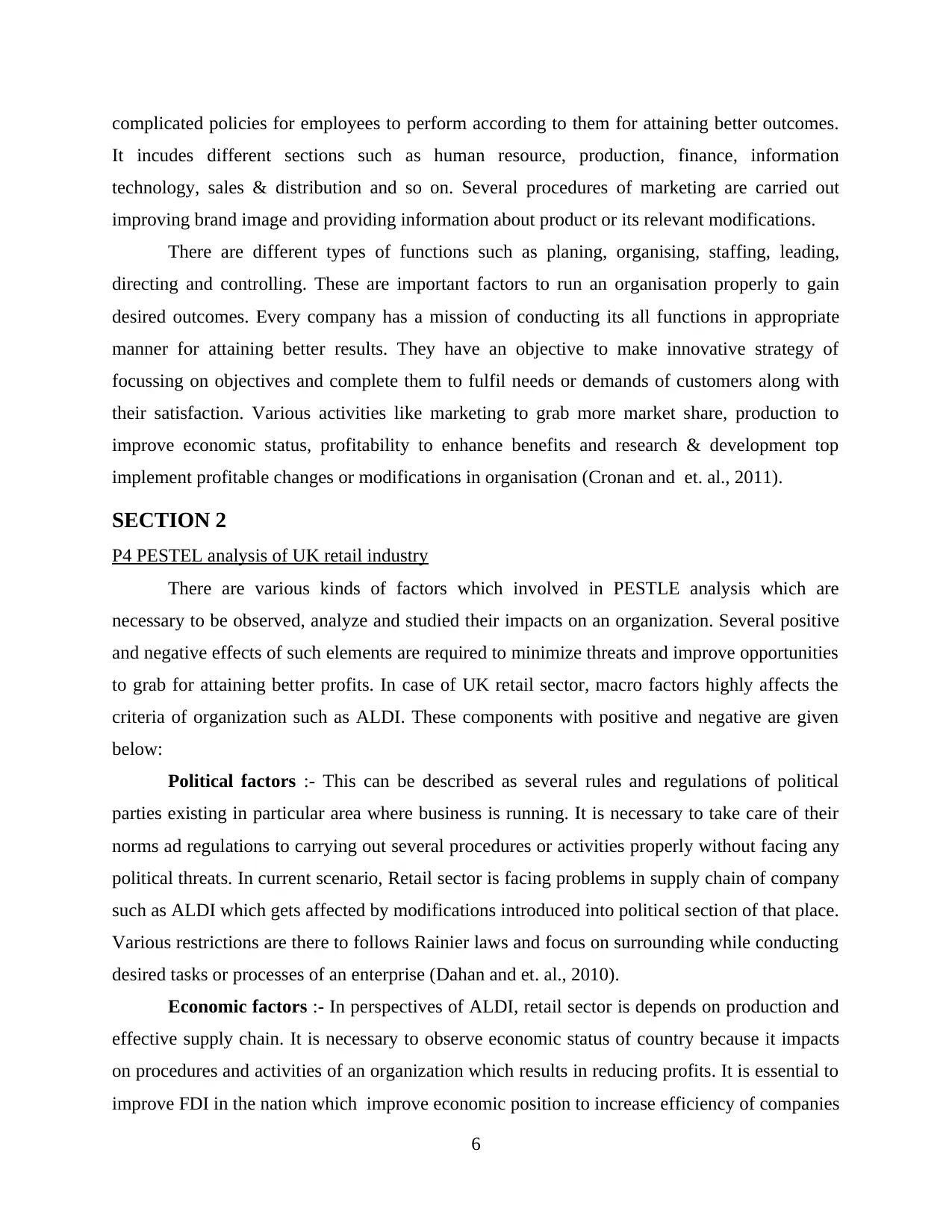
complicated policies for employees to perform according to them for attaining better outcomes.
It incudes different sections such as human resource, production, finance, information
technology, sales & distribution and so on. Several procedures of marketing are carried out
improving brand image and providing information about product or its relevant modifications.
There are different types of functions such as planing, organising, staffing, leading,
directing and controlling. These are important factors to run an organisation properly to gain
desired outcomes. Every company has a mission of conducting its all functions in appropriate
manner for attaining better results. They have an objective to make innovative strategy of
focussing on objectives and complete them to fulfil needs or demands of customers along with
their satisfaction. Various activities like marketing to grab more market share, production to
improve economic status, profitability to enhance benefits and research & development top
implement profitable changes or modifications in organisation (Cronan and et. al., 2011).
SECTION 2
P4 PESTEL analysis of UK retail industry
There are various kinds of factors which involved in PESTLE analysis which are
necessary to be observed, analyze and studied their impacts on an organization. Several positive
and negative effects of such elements are required to minimize threats and improve opportunities
to grab for attaining better profits. In case of UK retail sector, macro factors highly affects the
criteria of organization such as ALDI. These components with positive and negative are given
below:
Political factors :- This can be described as several rules and regulations of political
parties existing in particular area where business is running. It is necessary to take care of their
norms ad regulations to carrying out several procedures or activities properly without facing any
political threats. In current scenario, Retail sector is facing problems in supply chain of company
such as ALDI which gets affected by modifications introduced into political section of that place.
Various restrictions are there to follows Rainier laws and focus on surrounding while conducting
desired tasks or processes of an enterprise (Dahan and et. al., 2010).
Economic factors :- In perspectives of ALDI, retail sector is depends on production and
effective supply chain. It is necessary to observe economic status of country because it impacts
on procedures and activities of an organization which results in reducing profits. It is essential to
improve FDI in the nation which improve economic position to increase efficiency of companies
6
It incudes different sections such as human resource, production, finance, information
technology, sales & distribution and so on. Several procedures of marketing are carried out
improving brand image and providing information about product or its relevant modifications.
There are different types of functions such as planing, organising, staffing, leading,
directing and controlling. These are important factors to run an organisation properly to gain
desired outcomes. Every company has a mission of conducting its all functions in appropriate
manner for attaining better results. They have an objective to make innovative strategy of
focussing on objectives and complete them to fulfil needs or demands of customers along with
their satisfaction. Various activities like marketing to grab more market share, production to
improve economic status, profitability to enhance benefits and research & development top
implement profitable changes or modifications in organisation (Cronan and et. al., 2011).
SECTION 2
P4 PESTEL analysis of UK retail industry
There are various kinds of factors which involved in PESTLE analysis which are
necessary to be observed, analyze and studied their impacts on an organization. Several positive
and negative effects of such elements are required to minimize threats and improve opportunities
to grab for attaining better profits. In case of UK retail sector, macro factors highly affects the
criteria of organization such as ALDI. These components with positive and negative are given
below:
Political factors :- This can be described as several rules and regulations of political
parties existing in particular area where business is running. It is necessary to take care of their
norms ad regulations to carrying out several procedures or activities properly without facing any
political threats. In current scenario, Retail sector is facing problems in supply chain of company
such as ALDI which gets affected by modifications introduced into political section of that place.
Various restrictions are there to follows Rainier laws and focus on surrounding while conducting
desired tasks or processes of an enterprise (Dahan and et. al., 2010).
Economic factors :- In perspectives of ALDI, retail sector is depends on production and
effective supply chain. It is necessary to observe economic status of country because it impacts
on procedures and activities of an organization which results in reducing profits. It is essential to
improve FDI in the nation which improve economic position to increase efficiency of companies
6
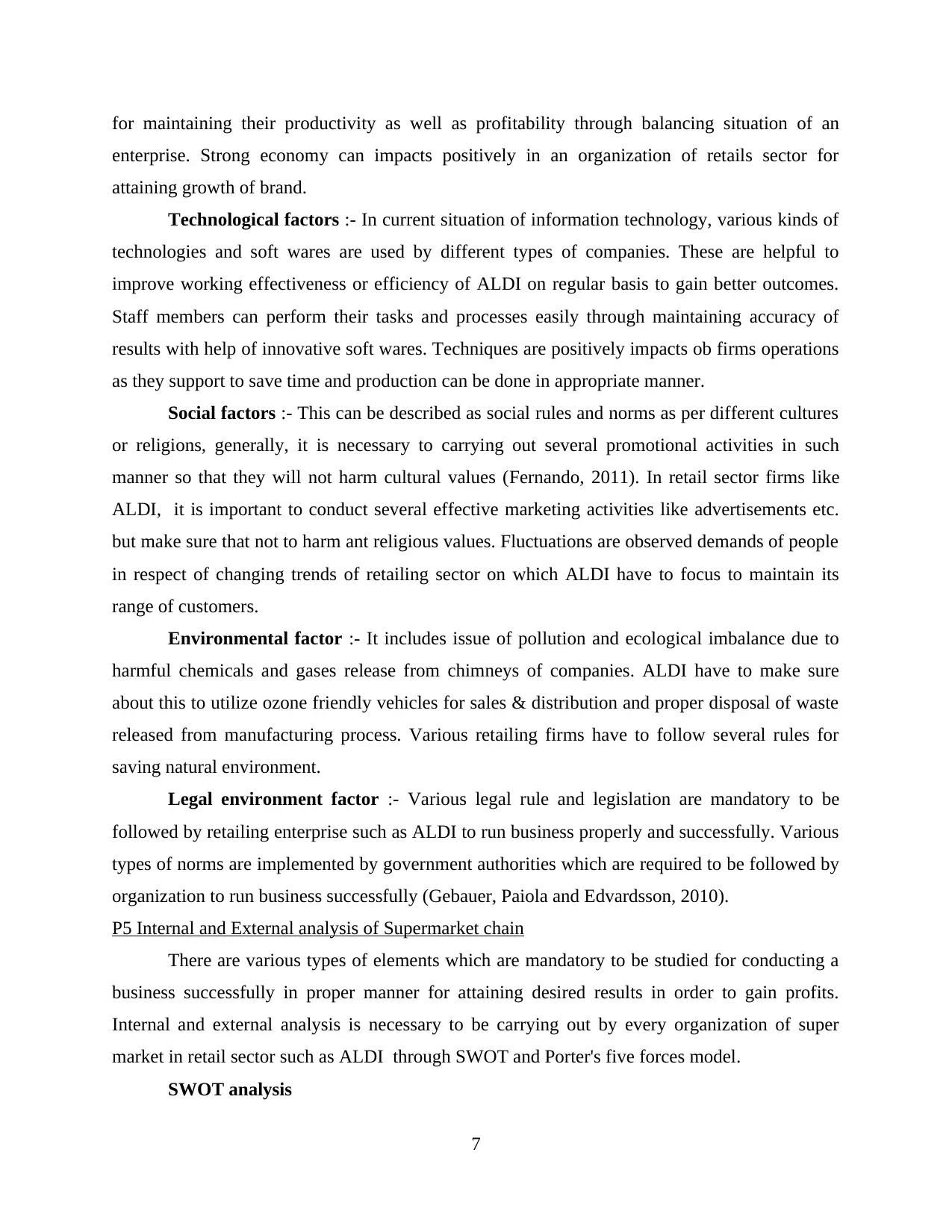
for maintaining their productivity as well as profitability through balancing situation of an
enterprise. Strong economy can impacts positively in an organization of retails sector for
attaining growth of brand.
Technological factors :- In current situation of information technology, various kinds of
technologies and soft wares are used by different types of companies. These are helpful to
improve working effectiveness or efficiency of ALDI on regular basis to gain better outcomes.
Staff members can perform their tasks and processes easily through maintaining accuracy of
results with help of innovative soft wares. Techniques are positively impacts ob firms operations
as they support to save time and production can be done in appropriate manner.
Social factors :- This can be described as social rules and norms as per different cultures
or religions, generally, it is necessary to carrying out several promotional activities in such
manner so that they will not harm cultural values (Fernando, 2011). In retail sector firms like
ALDI, it is important to conduct several effective marketing activities like advertisements etc.
but make sure that not to harm ant religious values. Fluctuations are observed demands of people
in respect of changing trends of retailing sector on which ALDI have to focus to maintain its
range of customers.
Environmental factor :- It includes issue of pollution and ecological imbalance due to
harmful chemicals and gases release from chimneys of companies. ALDI have to make sure
about this to utilize ozone friendly vehicles for sales & distribution and proper disposal of waste
released from manufacturing process. Various retailing firms have to follow several rules for
saving natural environment.
Legal environment factor :- Various legal rule and legislation are mandatory to be
followed by retailing enterprise such as ALDI to run business properly and successfully. Various
types of norms are implemented by government authorities which are required to be followed by
organization to run business successfully (Gebauer, Paiola and Edvardsson, 2010).
P5 Internal and External analysis of Supermarket chain
There are various types of elements which are mandatory to be studied for conducting a
business successfully in proper manner for attaining desired results in order to gain profits.
Internal and external analysis is necessary to be carrying out by every organization of super
market in retail sector such as ALDI through SWOT and Porter's five forces model.
SWOT analysis
7
enterprise. Strong economy can impacts positively in an organization of retails sector for
attaining growth of brand.
Technological factors :- In current situation of information technology, various kinds of
technologies and soft wares are used by different types of companies. These are helpful to
improve working effectiveness or efficiency of ALDI on regular basis to gain better outcomes.
Staff members can perform their tasks and processes easily through maintaining accuracy of
results with help of innovative soft wares. Techniques are positively impacts ob firms operations
as they support to save time and production can be done in appropriate manner.
Social factors :- This can be described as social rules and norms as per different cultures
or religions, generally, it is necessary to carrying out several promotional activities in such
manner so that they will not harm cultural values (Fernando, 2011). In retail sector firms like
ALDI, it is important to conduct several effective marketing activities like advertisements etc.
but make sure that not to harm ant religious values. Fluctuations are observed demands of people
in respect of changing trends of retailing sector on which ALDI have to focus to maintain its
range of customers.
Environmental factor :- It includes issue of pollution and ecological imbalance due to
harmful chemicals and gases release from chimneys of companies. ALDI have to make sure
about this to utilize ozone friendly vehicles for sales & distribution and proper disposal of waste
released from manufacturing process. Various retailing firms have to follow several rules for
saving natural environment.
Legal environment factor :- Various legal rule and legislation are mandatory to be
followed by retailing enterprise such as ALDI to run business properly and successfully. Various
types of norms are implemented by government authorities which are required to be followed by
organization to run business successfully (Gebauer, Paiola and Edvardsson, 2010).
P5 Internal and External analysis of Supermarket chain
There are various types of elements which are mandatory to be studied for conducting a
business successfully in proper manner for attaining desired results in order to gain profits.
Internal and external analysis is necessary to be carrying out by every organization of super
market in retail sector such as ALDI through SWOT and Porter's five forces model.
SWOT analysis
7
⊘ This is a preview!⊘
Do you want full access?
Subscribe today to unlock all pages.

Trusted by 1+ million students worldwide
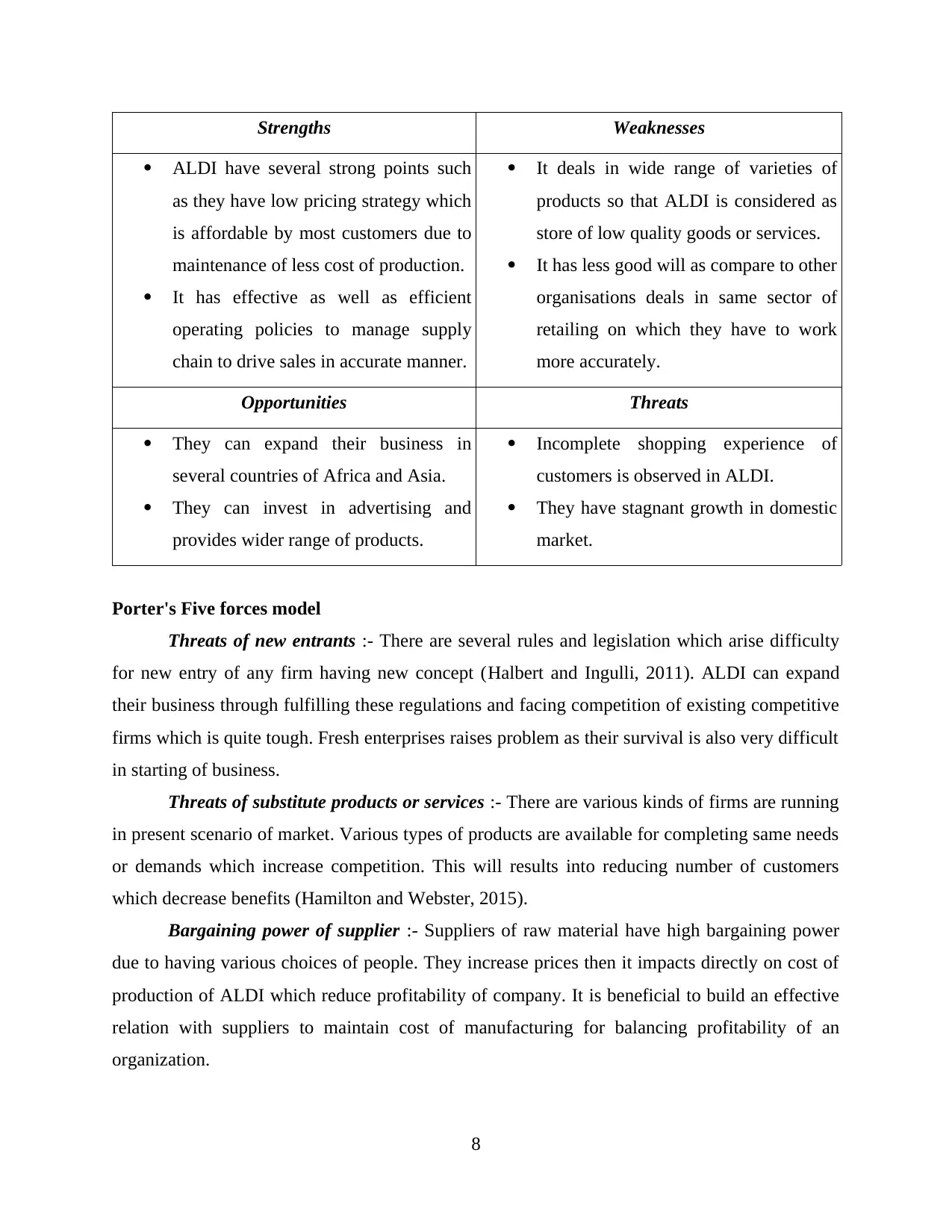
Strengths Weaknesses
ALDI have several strong points such
as they have low pricing strategy which
is affordable by most customers due to
maintenance of less cost of production.
It has effective as well as efficient
operating policies to manage supply
chain to drive sales in accurate manner.
It deals in wide range of varieties of
products so that ALDI is considered as
store of low quality goods or services.
It has less good will as compare to other
organisations deals in same sector of
retailing on which they have to work
more accurately.
Opportunities Threats
They can expand their business in
several countries of Africa and Asia.
They can invest in advertising and
provides wider range of products.
Incomplete shopping experience of
customers is observed in ALDI.
They have stagnant growth in domestic
market.
Porter's Five forces model
Threats of new entrants :- There are several rules and legislation which arise difficulty
for new entry of any firm having new concept (Halbert and Ingulli, 2011). ALDI can expand
their business through fulfilling these regulations and facing competition of existing competitive
firms which is quite tough. Fresh enterprises raises problem as their survival is also very difficult
in starting of business.
Threats of substitute products or services :- There are various kinds of firms are running
in present scenario of market. Various types of products are available for completing same needs
or demands which increase competition. This will results into reducing number of customers
which decrease benefits (Hamilton and Webster, 2015).
Bargaining power of supplier :- Suppliers of raw material have high bargaining power
due to having various choices of people. They increase prices then it impacts directly on cost of
production of ALDI which reduce profitability of company. It is beneficial to build an effective
relation with suppliers to maintain cost of manufacturing for balancing profitability of an
organization.
8
ALDI have several strong points such
as they have low pricing strategy which
is affordable by most customers due to
maintenance of less cost of production.
It has effective as well as efficient
operating policies to manage supply
chain to drive sales in accurate manner.
It deals in wide range of varieties of
products so that ALDI is considered as
store of low quality goods or services.
It has less good will as compare to other
organisations deals in same sector of
retailing on which they have to work
more accurately.
Opportunities Threats
They can expand their business in
several countries of Africa and Asia.
They can invest in advertising and
provides wider range of products.
Incomplete shopping experience of
customers is observed in ALDI.
They have stagnant growth in domestic
market.
Porter's Five forces model
Threats of new entrants :- There are several rules and legislation which arise difficulty
for new entry of any firm having new concept (Halbert and Ingulli, 2011). ALDI can expand
their business through fulfilling these regulations and facing competition of existing competitive
firms which is quite tough. Fresh enterprises raises problem as their survival is also very difficult
in starting of business.
Threats of substitute products or services :- There are various kinds of firms are running
in present scenario of market. Various types of products are available for completing same needs
or demands which increase competition. This will results into reducing number of customers
which decrease benefits (Hamilton and Webster, 2015).
Bargaining power of supplier :- Suppliers of raw material have high bargaining power
due to having various choices of people. They increase prices then it impacts directly on cost of
production of ALDI which reduce profitability of company. It is beneficial to build an effective
relation with suppliers to maintain cost of manufacturing for balancing profitability of an
organization.
8
Paraphrase This Document
Need a fresh take? Get an instant paraphrase of this document with our AI Paraphraser
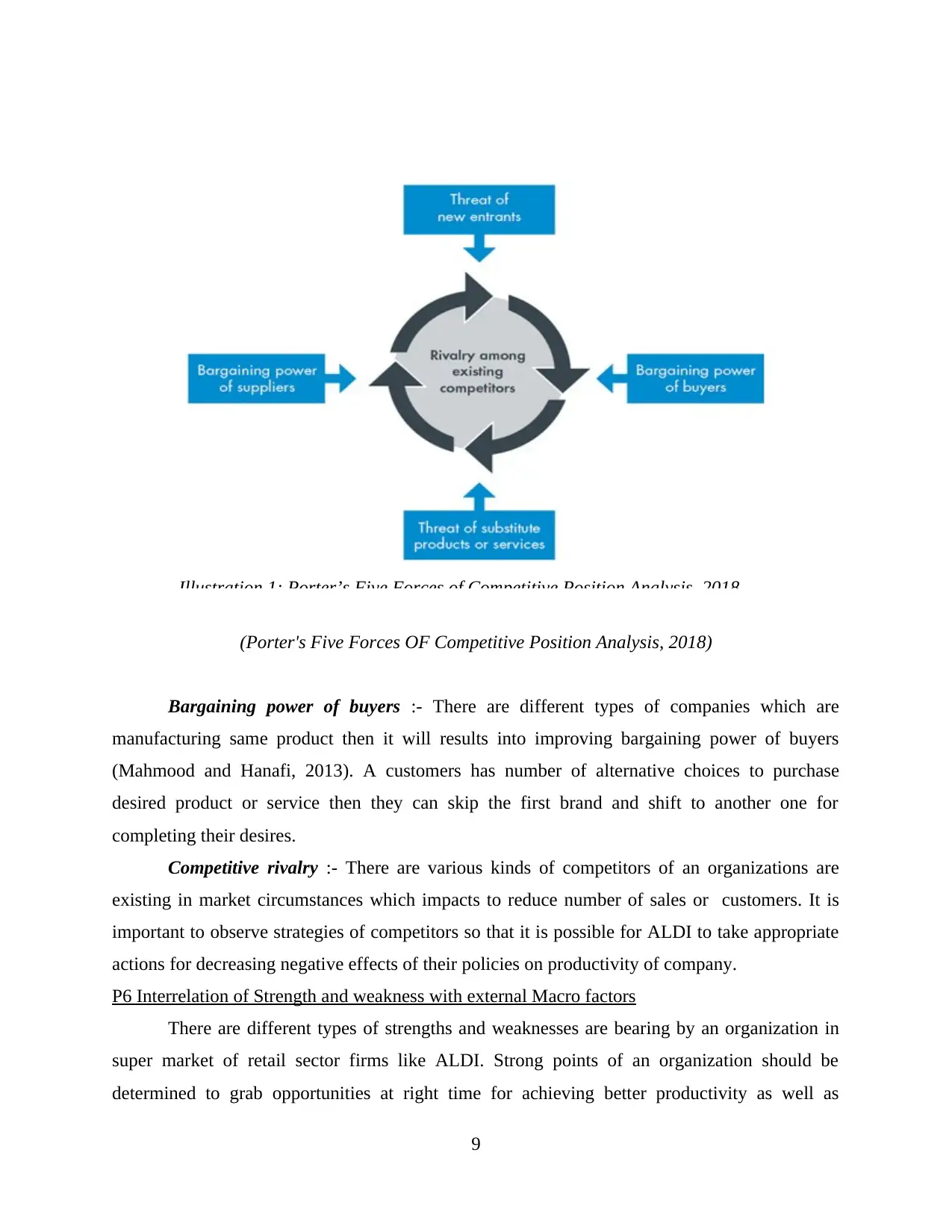
(Porter's Five Forces OF Competitive Position Analysis, 2018)
Bargaining power of buyers :- There are different types of companies which are
manufacturing same product then it will results into improving bargaining power of buyers
(Mahmood and Hanafi, 2013). A customers has number of alternative choices to purchase
desired product or service then they can skip the first brand and shift to another one for
completing their desires.
Competitive rivalry :- There are various kinds of competitors of an organizations are
existing in market circumstances which impacts to reduce number of sales or customers. It is
important to observe strategies of competitors so that it is possible for ALDI to take appropriate
actions for decreasing negative effects of their policies on productivity of company.
P6 Interrelation of Strength and weakness with external Macro factors
There are different types of strengths and weaknesses are bearing by an organization in
super market of retail sector firms like ALDI. Strong points of an organization should be
determined to grab opportunities at right time for achieving better productivity as well as
9
Illustration 1: Porter’s Five Forces of Competitive Position Analysis, 2018
Bargaining power of buyers :- There are different types of companies which are
manufacturing same product then it will results into improving bargaining power of buyers
(Mahmood and Hanafi, 2013). A customers has number of alternative choices to purchase
desired product or service then they can skip the first brand and shift to another one for
completing their desires.
Competitive rivalry :- There are various kinds of competitors of an organizations are
existing in market circumstances which impacts to reduce number of sales or customers. It is
important to observe strategies of competitors so that it is possible for ALDI to take appropriate
actions for decreasing negative effects of their policies on productivity of company.
P6 Interrelation of Strength and weakness with external Macro factors
There are different types of strengths and weaknesses are bearing by an organization in
super market of retail sector firms like ALDI. Strong points of an organization should be
determined to grab opportunities at right time for achieving better productivity as well as
9
Illustration 1: Porter’s Five Forces of Competitive Position Analysis, 2018
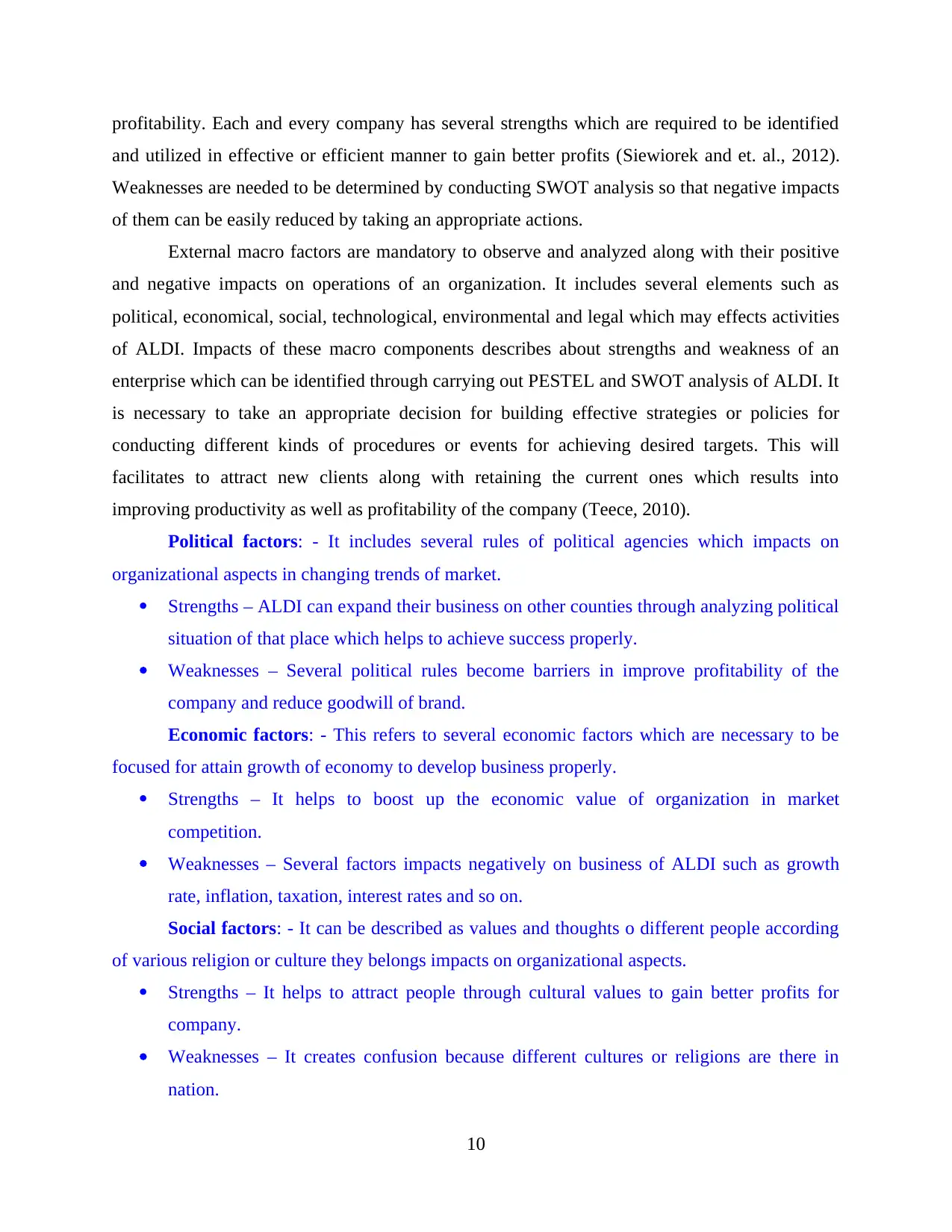
profitability. Each and every company has several strengths which are required to be identified
and utilized in effective or efficient manner to gain better profits (Siewiorek and et. al., 2012).
Weaknesses are needed to be determined by conducting SWOT analysis so that negative impacts
of them can be easily reduced by taking an appropriate actions.
External macro factors are mandatory to observe and analyzed along with their positive
and negative impacts on operations of an organization. It includes several elements such as
political, economical, social, technological, environmental and legal which may effects activities
of ALDI. Impacts of these macro components describes about strengths and weakness of an
enterprise which can be identified through carrying out PESTEL and SWOT analysis of ALDI. It
is necessary to take an appropriate decision for building effective strategies or policies for
conducting different kinds of procedures or events for achieving desired targets. This will
facilitates to attract new clients along with retaining the current ones which results into
improving productivity as well as profitability of the company (Teece, 2010).
Political factors: - It includes several rules of political agencies which impacts on
organizational aspects in changing trends of market.
Strengths – ALDI can expand their business on other counties through analyzing political
situation of that place which helps to achieve success properly.
Weaknesses – Several political rules become barriers in improve profitability of the
company and reduce goodwill of brand.
Economic factors: - This refers to several economic factors which are necessary to be
focused for attain growth of economy to develop business properly.
Strengths – It helps to boost up the economic value of organization in market
competition.
Weaknesses – Several factors impacts negatively on business of ALDI such as growth
rate, inflation, taxation, interest rates and so on.
Social factors: - It can be described as values and thoughts o different people according
of various religion or culture they belongs impacts on organizational aspects.
Strengths – It helps to attract people through cultural values to gain better profits for
company.
Weaknesses – It creates confusion because different cultures or religions are there in
nation.
10
and utilized in effective or efficient manner to gain better profits (Siewiorek and et. al., 2012).
Weaknesses are needed to be determined by conducting SWOT analysis so that negative impacts
of them can be easily reduced by taking an appropriate actions.
External macro factors are mandatory to observe and analyzed along with their positive
and negative impacts on operations of an organization. It includes several elements such as
political, economical, social, technological, environmental and legal which may effects activities
of ALDI. Impacts of these macro components describes about strengths and weakness of an
enterprise which can be identified through carrying out PESTEL and SWOT analysis of ALDI. It
is necessary to take an appropriate decision for building effective strategies or policies for
conducting different kinds of procedures or events for achieving desired targets. This will
facilitates to attract new clients along with retaining the current ones which results into
improving productivity as well as profitability of the company (Teece, 2010).
Political factors: - It includes several rules of political agencies which impacts on
organizational aspects in changing trends of market.
Strengths – ALDI can expand their business on other counties through analyzing political
situation of that place which helps to achieve success properly.
Weaknesses – Several political rules become barriers in improve profitability of the
company and reduce goodwill of brand.
Economic factors: - This refers to several economic factors which are necessary to be
focused for attain growth of economy to develop business properly.
Strengths – It helps to boost up the economic value of organization in market
competition.
Weaknesses – Several factors impacts negatively on business of ALDI such as growth
rate, inflation, taxation, interest rates and so on.
Social factors: - It can be described as values and thoughts o different people according
of various religion or culture they belongs impacts on organizational aspects.
Strengths – It helps to attract people through cultural values to gain better profits for
company.
Weaknesses – It creates confusion because different cultures or religions are there in
nation.
10
⊘ This is a preview!⊘
Do you want full access?
Subscribe today to unlock all pages.

Trusted by 1+ million students worldwide
1 out of 15
Related Documents
Your All-in-One AI-Powered Toolkit for Academic Success.
+13062052269
info@desklib.com
Available 24*7 on WhatsApp / Email
![[object Object]](/_next/static/media/star-bottom.7253800d.svg)
Unlock your academic potential
Copyright © 2020–2025 A2Z Services. All Rights Reserved. Developed and managed by ZUCOL.





